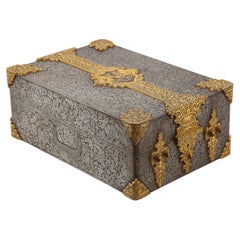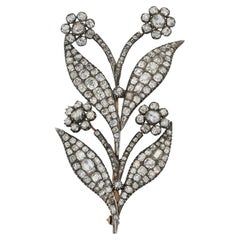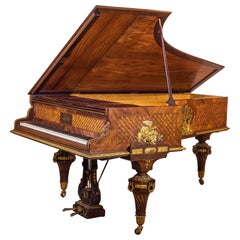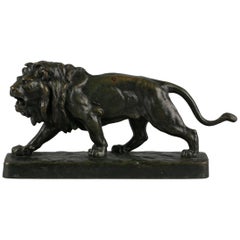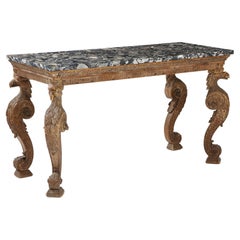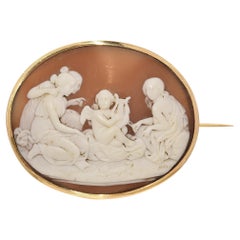Manhattan
to
58
977
15,393
9,782
88,825
62,817
39,647
22,794
17,527
12,442
8,806
6,301
5,382
5,201
4,468
4,454
4,211
3,980
3,875
2,731
2,727
1,889
1,501
1,224
1,129
977
849
786
761
404
394
316
232
192
186
167
165
157
124
79
69
54
49
49
45
40
39
39
36
31
17
10
9
8
7
7
6
6
5
5
4
4
2
2
1
21
11
10
10
9
Period: Mid-19th Century
Period: 1860s
19th C. Royal Casket Box/Safe with Coat of Arms, Gold, Damascene, Etched Steel
Located in New York, NY
An Incredible 19th Century Royal Casket Box/Safe with Coat of Arms, Made of Gold, Damascene, and Etched Steel. Charles Le Hon, a Belgian politician, lawyer and industrialist, served...
Category
1850s French Renaissance Revival Antique Manhattan
Materials
Gold, Steel
Antique Diamond Flower Brooch
Located in New York, NY
Dating from the mid-19th century, this silver and gold flower brooch is set with over 13 carats of old diamonds. It is designed as a frond of curling leaves and blossoms, set through...
Category
Mid-19th Century Victorian Antique Manhattan
Materials
Diamond, Gold, Silver
Important Ormolu-Mounted Amaranth, Kingwood and Satine Parquetry Grand Piano
By Henry Dasson
Located in New York, NY
Attributed to Henry Dasson (d. 1896)
Origin: French
Date: circa 1885-q890
Dimension: (H) 35 1/4 in x (W) 54 in x (W) 78 in.
Provenance: Acquired by Dr. J. T Nieto-Gomez from fi...
Category
Mid-19th Century French Louis XVI Antique Manhattan
Materials
Bronze
French Bronze Figure of a Striding Lion, circa 1860
Located in New York, NY
French bronze figure of a striding lion, circa 1860
Signed by Louis Vidal (1831-1892).
Category
1860s French Antique Manhattan
Materials
Bronze
English Console Table in Kentian Manner
Located in Greenwich, CT
A very fine English marble top console table in the manner of William Kent, having features found in documented examples of Kent's work at Chiswick House and Holkham Hall. Reeded and...
Category
1830s British Antique Manhattan
Materials
Marble
Antique 17K Yellow Gold Cherub and Three Women Shell Cameo Brooch
Located in New York, NY
This exquisite piece is crafted in yellow gold, featuring an intricately carved relief.
The design showcases three women and a cherub. The cameo is set within an oval frame, highligh...
Category
Mid-19th Century Antique Manhattan
Materials
Yellow Gold
Antique Victorian Locket 14 Karat Gold Etruscan Revival Pendant Circa 1860
Located in New York, NY
This is a gorgeous 14 Karat Gold Victorian - Belle Epoque Picture Locket pendant in an Etruscan Revival Design of great beauty. The locket has the most stunning warm brushed 14 Kara...
Category
Mid-19th Century Unknown Victorian Antique Manhattan
Materials
Gold, 14k Gold
A 19th Century Meissen Porcelain Ormolu Mounted Hinged Box with Watteau Scene
By Meissen Porcelain
Located in New York, NY
A 19th Century Meissen Porcelain Ormolu Mounted Hinged Box with Watteau Scene Cartouche and the Interior Decorated with Floral Designs.
The box features an ormolu-mounted structure w...
Category
1860s German Rococo Antique Manhattan
Materials
Bronze
Meissen Porcelain Figural Group of Musician Lovers on Sofa, After J.J. Kandler
By Meissen Porcelain
Located in New York, NY
A 19th C. Meissen Porcelain Figural Group of Musician Lovers seated on a Sofa with a Pug Dog, After J.J. Kandler. The piece depicts a man and a woman seated on an ornate sofa, each engaged in a musical performance. The woman is elegantly attired in a gown adorned with delicate floral motifs, playing a lute, while the man is dressed in fine blue and gold attire, playing a flute. Their facial expressions reflect concentration and grace as they engage in a shared musical moment. The intricate detailing in their clothing, including the delicate folds of the fabric and the fine detailing of the lace and ribbons, the 24k Gold...
Category
1860s German Rococo Antique Manhattan
Materials
Porcelain
Antique French Aubusson Rug. 14 ft 8 in x 15 ft 2 in
Located in New York, NY
Gorgeous Antique French Aubusson Square Area Rug, country of origin / rug type: French rug, Circa date: 1870’s. Size: 14 ft 8 in x 15 ft 2 in (4.47 m x 4.62 m)
Category
Mid-19th Century French Aubusson Antique Manhattan
Materials
Wool
Antique Victorian Yellow Gold Carnelian Intaglio Signet Ring
Located in New York, NY
Exuding timeless elegance, this striking ring features a rectangular Carnelian intricately carved with a rare double head. The stone is set in a warm, gold-toned band adorned with de...
Category
Mid-19th Century Antique Manhattan
Materials
Carnelian, Yellow Gold
Paris Porcelain Tea Service, circa 1860
Located in New York, NY
Comprising 2 pots, creamer (handle restored), covered sugar (finial restored), and 8 cups and saucers.
Category
1860s French Antique Manhattan
Materials
Porcelain
Pair Rouge Marble ‘Grand Tour’ Models of Ruins Celebrating the Corinthian Order
By Benedetto Boschetti
Located in New York, NY
A Large and Incredible Pair of Rouge Marble ‘Grand Tour’ Models of Ruins Celebrating the Corinthian Order, Most Probably Attributed To The Workshop Of Benedetto Boschetti. The fist ...
Category
1860s Italian Grand Tour Antique Manhattan
Materials
Marble
Large Antique Italian Micro Mosaic plaque of St. Peters Square, Rome mid 1800's
By Vatican Mosaic Studio
Located in New York, NY
A Very Large and Exceptionally Fine Quality Antique Italian Micro-Mosaic Plaque Depicting "The Saint Peter Square" in Rome. The center medallion surrounded by a beautiful Laurel Wreath in multiple shades of Green Mosaic amidst a black Belgium Marble border. The interior rounded subject depicts Saint Peter Square which is found in Rome, Italy. The entire center panel is made up of a captivating array of tesserae in a variety of shapes and colors, which create this stunning mosaic construct. When inspected from up-close, small rectangular tesserae are found in an assortment of colors, which include: white, green, blue, red, black, brown, orange etc. When the subject is seen from afar, a fantastic image of the entire Saint Peter Square can be viewed as if a painting has been created. The oil on canvas of this scene, by was sold in Christie's Auction for over $2,000,000 USD. The plaque rests in a custom ebonized and gilt square frame. This can be used as a decorative object on the wall to serve as a painting, or, be converted to a table-top by mounting it on a table stand.
Rome, Circa: 1850
Giovanni Paolo Panini (Piacenza 1691-1765 Rome), View of Saint Peter's Square, Rome.
From Christie's Auction:
Giovanni Paolo Panini arrived in Rome in 1711, painting capricci and architectural pieces in a vigorous if slightly eccentric style, and by 1719, when he was admitted to the Academy of St. Luke and the virtuosi al Pantheon, he was a rising star in the Roman art world. From around 1719-1726 he was much in demand for decorative frescoes, including quadratura, ornament and landscape and other genres, often in collaboration with figure or flower painters. During this period he worked for Cardinal Patrizi at Villa Patrizi, Cardinal Annibale Albani at Palazzo Albani (now del Drago) alle Quattro Fontane, Livio de Carolis at Palazzo de Carolis, Cardinal Alberoni at Palazzo Alberoni, Innocent XIII Conti in the Quirinal and in the library of S. Croce in Gerusalemme. In 1724 he married Caterina Gosset, the sister-in-law of Nicolas Vleughels, the director of the French Academy in Rome, to which he was admitted in 1732, and as a result he was much patronized by the French. During the 1720s he developed his figure style away from the awkwardness of his early works into one that concentrated on groups of stylishly-dressed aristocrats and skillfully modelled bystanders, sibyls and pseudo-antique figures. These he noted down in drawings (such as a sketchbook in the British Museum) that he drew upon to populate his paintings. He also began to receive commissions to design and record temporary festivals, often for French ambassadors to Rome.
By the beginning of the 1730s Panini was developing a distinctive subgenre of the capriccio in which recognizable monuments are placed in imaginary topographical relationships, which were well-received in the classicizing era of Clement XII Corsini. In 1732 he was one of the panel of judges for the competition instituted by Clement for the Lateran façade, and in the following year painted an impressive View of Piazza del Quirinale for the pope. At about this time he was developing his best-known topographical subjects, interior views of St Peter's and the Pantheon, which were much in demand, to judge by the number of extant versions extending into the 1750s. By about 1734 he was beginning to attract the attention of English patrons, who ordered sets of Roman views, such as those at Marble Hill House (1738) and Castle Howard. In 1736, through Filippo Juvarra, he received important commissions from Philip V of Spain for scenes of the life of Christ in the Chinoiserie room at La Granja in Spain (1736). From as early as the 1720s he had been producing some vedute (view-paintings), initially based on prototypes by Gaspar van Wittel, and he developed the genre in subsequent decades in works that would include impressive panoramic views of the Forum or Palatine, although his staple genre was the capriccio rather than the veduta. He also expanded his repertory of church interiors, adding such churches as S. Paolo fuori le Mura and S. Agnese in Piazza Navona, as well as church interiors recording special events. His son by his first marriage, Giuseppe (1718-1805), began to support him in architectural and festival design projects.
By the 1740s Panini was at the peak of his powers, and evidently had a considerable workshop helping him meet demand, especially of capricci to be used as overdoors and other decorative installations. Giovanni Paolo was successful in elevating himself socially above the usual artisanal status of genre painters, and would sometimes include a self-portrait in paintings commissioned by the great and powerful. He also appears to have been successful financially, and owned a substantial palazzo in via Monserrato. He increasingly concentrated on important commissions, such as a view of the Lottery in Piazza Montecitorio (London, National Gallery, 1743-1744), the designs for the festival decorations for the birth of the Dauphin in Palazzo Farnese (Waddesdon Manor, 1751), or the view of an imaginary picture gallery housing the collection of Cardinal Valenti Gonzaga (Wadsworth Atheneum, 1749). In the mid-1750s he received an important series of commissions from the Duc de Choiseul, French ambassador to Rome and soon to become one of the most powerful men in France, that included his best-known compositions, Ancient Rome (Roma Antica) and Modern Rome (Roma Moderna). These large paintings, of which there are three sets (in Boston and Stuttgart, the Metropolitan Museum, and the Louvre) represent imaginary picture galleries based on the Valenti Gonzaga composition but hung with what purport to be Panini's own vedute of ancient and modern sites respectively (with corresponding pieces of sculpture). These paintings sum up the eighteenth-century canon of the greatest works of architecture and sculpture, and the equivalence between modern and ancient Rome. By this time Panini was being assisted by his son by his second marriage, Francesco (1748-1800), who was a skilled draughtsman and painter who continued his father's work after his death in 1765.
The Farnborough Hall paintings
The Piazza S. Pietro and the Campidoglio are important vedute by Panini painted in 1750 and originally installed, with other works by Panini and Canaletto, in the seat of the Holbech family, Farnborough Hall, Warwickshire (National Trust). Farnborough Hall had been inherited in 1717 by William Holbech (circa 1699-1771), who is documented on the Grand Tour in Florence, Rome and Venice from late 1732 until his return home at the end of April 1734 with his brother Hugh. Holbech is said to have gone on the Grand Tour to recover from a broken heart and to have spent a considerable time there prior to these documented appearances. During his time in Rome he acquired two Paninis, which were seen by an anonymous antiquary around 1746, who referred to various sculptures "all brought from Rome with two pictures, one of the Rotunda, and the other of diverse buildings by Panino" (British Library, Add. MS 6230, pp. 31-32). The Rotunda (the Pantheon) is a painting now in a private collection in New York, and is signed and dated 1734. The Diverse Buildings, which was probably one of Panini's capricci, has not been identified. On his Grand Tour Holbech seems also to have acquired two Canalettos, although they are not mentioned by the antiquary, who may only have had eyes for things Roman.
In about 1746-1747, Holbech remodelled the house by creating a Saloon, now the dining room, at the back of the house. This room, the entrance hall, the staircase, library and closet were stuccoed by William Perritt of York, and a bill for this work dated 14 November 1750 survives (or survived until recently; G. Beard, Decorative Plasterwork in Great Britain, London, 1975, p. 233). The two Canalettos acquired on the Grand Tour were installed in the Saloon, together with two new works commissioned from Canaletto, who was then in England and working nearby at Warwick Castle in 1748. The two Paninis acquired on the Grand Tour may have been installed in the Library, as Alastair Laing assumes (op. cit.), while three new works commissioned from Panini in Rome were placed in the Hall and Saloon: the Piazza S. Pietro for the overmantel in the Hall (fig. 1), the Campidoglio as the overmantel in the Saloon (fig. 2), and an Interior of St Peter's (now in Detroit) (fig. 3) on the adjacent wall facing the windows. Two of the Canalettos flanked the Campidoglio, while the others were on the opposite wall. The Interior of St Peter's was therefore effectively the fifth member of the Canaletto set, distinct from the two overmantels.
Holbech's installation of his Canalettos and Paninis in fixed stucco frames was unusual for England in 1750, and had probably been inspired by what he had seen on his Grand Tour in Northern Italy, where fixed stucco installations of canvases were common in the 1720s and 1730s (Cornforth, II, p. 51). The Campidoglio and the Interior of St Peter's are both signed and dated 1750, a date that corresponds to the payments for the stucco.
The commission for the new Paninis would have been made through an agent, possibly the Roman dealer in antiquities Belisario Amidei from whom some of the antique busts in the Hall were acquired in 1745, who was also a picture dealer; or perhaps the painter Pietro Berton, who on 7 December 1750 shipped a Panini to England.
The paintings were sold to Savile Gallery in 1929 and replaced by copies by one Mohammed Ayoub. The four Canalettos were exhibited at Savile Gallery in 1930 and entered the London art trade, finding their way at various times to Augsburg, Melbourne, Ottawa and a private collection. The Paninis seem to have been resold immediately to Knoedler & Co. in New York. When the stucco was removed from the library by Holbech's great-grandson, another William Holbech, shortly after his succession in 1812, the Interior of the Pantheon and the Diverse Buildings may have been taken down. Although there is no record of either painting being at Farnborough subsequently, the Interior of the Pantheon at least must have remained there, since it appeared at Knoedler's in 1930 at about the same time as the other Paninis, and was presumably acquired at the same time from the same source.
The Campidoglio was a rare subject for Panini: this is the only known extant version, apart from fictive versions in the Metropolitan Museum (1757) (figs. 4) and Louvre (1759) versions of his Roma Moderna composition (but not in the first Boston version of 1757). Probably Holbech insisted on the choice of subject in order to represent the centre of Rome's civic administration to complement the religious one of St Peter's. The Campidoglio may have been of interest to English patrons because it represented the seat of a form of government they were more comfortable with than the papacy. For example, Canaletto painted the subject, together with English subjects, for Thomas Hollis, 'the most bigoted of all Republicans' in 1755, who may have wanted to 'represent London as the heir to the legacy of Ancient Rome and Renaissance Italy' (see Michael Liversidge and Jane Farrington, eds., Canaletto and England, exhibition catalogue, Birmingham Museums and Art Gallery, London, 1993, p. 25). Canaletto also painted the subject for Sir Richard Neave, Ist Baronet (1731-1814) of Dagnam Park, Essex, at the end of his English stay or shortly afterwards (i.e. 1755-1766) (sold, Sotheby's, London, 10 July 2002, lot 8). Like Holbech, Neave mixed Venetian and Roman subjects, but his Roman subjects steer clear of St Peter's: the others were the Piazza del Quirinale and Piazza Navona. While Holbech had gone to both Venice and Rome and commissioned views of both cities, Rome sets the keynote for his decoration: antique busts line the Hall, and its religious and civic centres are the overmantels in the Hall and Saloon respectively.
The Piazza S. Pietro
The Piazza S. Pietro shows the piazza much as it appears today, apart from the absence of Valadier's late eighteenth-century clocks on the towers. Bernini's colonnade (1656-1667), both ends of which are visible, reaches out its arms to embrace the viewer. In the center of the piazza is the obelisk moved by Sixtus V in 1586 from the left side of the church where it had formed part of the Circus of Nero. On either side are two fountains, the one on the right by Carlo Maderno (1613) and the one on the left created to match it by Carlo Fontana in 1677. Beyond is the rectangular forecourt to the church, the piazza retta, leading to the façade by Maderno, completed in 1610, and the dome by Michelangelo, Giacomo della Porta and Domenico Fontana. To the right of the façade the roof of the Sistine Chapel is just visible, followed by the Cortile di S. Damaso, the palace of the Swiss Guards and the palace of Paul V. A Cardinal is being driven in a carriage across the piazza at the right in the direction of the Borgo Nuovo and Ponte S. Angelo with his blue-liveried retinue and subsidiary carriages. Unlike the later versions of the subject that depict the Duke de Choiseul, there seems to be no intent to portray any particular cardinal: the procession of a cardinal here is presented simply as characteristic activity within the piazza. Various groups of figures, including well-dressed women in brightly colored dresses, Swiss Guards, priests, gentlemen, idlers and a pilgrim are distributed around the piazza. In the foreground an imaginary heap of fallen masonry provides visual interest in an otherwise dead space.
Panini painted the Piazza S. Pietro on a number of occasions, and his works falls into two types, one with the viewpoint shifted slightly to left of the axis, as in the Farnborough Hall version, and one with it shifted slightly to the right. The first type is based on a composition by Gaspar van Wittel, of which there are numerous versions from 1684 until 1721 (Fig. 9 van Wittel). The work by Panini that seems closest to Van Wittel and therefore probably the earliest is the version in the Circolo della Caccia, Rome, which has been dated to the second half of the 1730s, but is probably a decade or so earlier. Another, on the London art market in 2002-2009, and a version with workshop participation at Sotheby's, Milan (20 November 2007, lot 137) and currently on the art market in Rome, are closer to an important painting in Toledo (Arisi no. 308) that is signed and dated 1741 (fig. 6).
Van Wittel employed a wide format (about 2:1), showed both of the end faces of the colonnade almost to their full extent, and introduced the theme of a heap of masonry to enliven the foreground. His choice of perspective implies a viewpoint located in the small piazza between the Borgo Nuovo and Borgo Vecchio, now the Piazza Pio XII at the top of the Via della Conciliazione. From this viewpoint a building at the left tended to interfere with the view of the end of the left arm, as can be seen from the Nolli map...
Category
1850s Italian Louis XVI Antique Manhattan
Materials
Glass
Antique 9K Yellow Gold Cherub with Grapes Shell Cameo Brooch
Located in New York, NY
Cherub with Grapes
Weight: 35.3 Grams
Stone: Shell
Measurements: 3.20 x 2.80 Inches
Metal: 9K
ITEM #: BR-1483-121824-17
Category
Mid-19th Century Antique Manhattan
Materials
9k Gold, Yellow Gold
Pair of Italian Walnut Chests of Drawers, Italy circa 1830
Located in New York, NY
A pair of large Italian three-drawer chests of drawers in walnut veneer. The commodes are of unusual shape, rounded at the bottom and resting on green and gold-patinated lion's paw f...
Category
Mid-19th Century Italian Antique Manhattan
Materials
Walnut
Pine Trestle End Table
Located in New York, NY
Pine trestle end table, handpicked by buyers at Ann-Morris Inc.
Category
Mid-19th Century British Antique Manhattan
Materials
Wood
Pair 19th Century French Patinated Bronze Alhambra Vases, Stamped Tiffany & Co.
By Tiffany & Co.
Located in New York, NY
An Incredible and Rare Pair of 19th Century French Islamic Style Patinated Bronze Alhambra Vases, Stamped Tiffany & Co. The vases draw inspiration from Islamic design and the Nasrid ...
Category
1860s French Islamic Antique Manhattan
Materials
Bronze
Fine English Porcelain Dessert Service, Minton, circa 1830
Located in New York, NY
Comprising 24 plates, pair of covered sauce tureens and stands, pair of shell dishes and a pair of rectangular dishes. The bright blue ground inters...
Category
1830s English Antique Manhattan
Materials
Porcelain
Pair 19th C. French Signed Baccarat Opaline Double Overlay Blue-Cut-White Vases
By Baccarat
Located in New York, NY
A Highly Important, Monumental, and Rare Pair of 19th Century French Signed Baccarat Opaline Double Overlay Cobalt Blue Cut-To-White Opaline Vases with Hand-Enameled Floral Designs, ...
Category
1860s French Louis XVI Antique Manhattan
Materials
Crystal
A Large 19th C. Meissen Porcelain Model of the Continent of Asia, Lady on Camel
By Meissen Porcelain
Located in New York, NY
A Magnificent and Large 19th Century Meissen Porcelain Model of the Continent of Asia. The figure wears an elaborate headdress with a blue and white mitre-like structure adorned with...
Category
1860s German Other Antique Manhattan
Materials
Porcelain
Drinks Cabinet
By Paolo Buffa, Mario Quarti
Located in New York, NY
Pyramid studded varnished wood body, gilded wooden legs, with two doors and bottom drop-down shelf, featuring interior glass shelves and original ke...
Category
1840s Italian Antique Manhattan
Materials
Glass, Wood
Pair of French Opaline Vases, Baccarat, circa 1835
By Baccarat
Located in New York, NY
Pair of French opaline bases, Baccarat, circa 1835.
Category
1830s French Antique Manhattan
Materials
Opaline Glass
Antique Gorham Tray Coin Silver Commemorating Early Indiana Railway
By Gorham Manufacturing Company
Located in New York, NY
Victorian Classical coin silver tray. Made by Gorham in Providence, ca 1860. Oval with four scroll-mounted strapwork supports. Beaded rim and leaf-mounted end handles with horned and...
Category
Mid-19th Century American Victorian Antique Manhattan
Materials
Silver
Paris Porcelain White and Gold Open-Work Centerpiece, circa 1840
Located in New York, NY
Paris porcelain white and gold open-work centerpiece, circa 1840.
Category
1840s French Antique Manhattan
Materials
Porcelain
Alexandre Henri Devaulx, Centaur Nursing her Baby, French Belle Epoque, c. 1880s
By Alexandre Henri Devaulx
Located in New York, NY
Signed “A.H. Devaulx”, and marked “Susse Fes Ed.20”
Dimensions: Height 6-7/8”, width 7-7/8”, depth 4-1/4”
This wonderfully unusual desktop sculpture of gilded bronze, depicting a beautiful female-centaur breastfeeding her cub is made in a classic romantic style of the Belle Epoque era by a remarkable French sculptor, Alexandre Henri Devaulx.
Alexandre Henri Devaulx (French, 1856-1940) was the son of the noted sculptor of the Romanticism period, François Théodore Devaulx (1808–1870). Born in Paris, he studied under E. Devaulx, making his début as a sculptor at the 1876 Paris Salon with Portrait, a plaster medallion. Alexandre Henri Devaulx became a member of the Artistes Français in 1888, winning an award with merit in the same year....
Susse Frères Bronze Foundry, Paris - The French firm Susse Frères manufactured a daguerreotype camera, which was one of the first two photographic cameras...
Category
1850s French Belle Époque Antique Manhattan
Materials
Bronze
3 Chinese porcelain spoons, 19th c.
Located in New York, NY
the two spoons decorated with fish motif are decorated in relief; a dragon-motif decorated spoon
Category
Mid-19th Century Chinese Antique Manhattan
Materials
Porcelain
A 19th C. Russian Ormolu-Mounted Hand-Carved Pink Rhodonite Tazza/Centerpiece
Located in New York, NY
A Fabulous and Large 19th Century Russian Ormolu-Mounted Hand-Carved Pink Rhodonite Tazza/Centerpiece. This tazza is a masterpiece of opulence that e...
Category
1860s Russian Louis XVI Antique Manhattan
Materials
Bronze
Louis Drimmer Ceramic Table Lamp with Blue & Yellow Faces on Green Body, France
By Louis Drimmer
Located in New York, NY
Large, Louis Drimmer ceramic table lamp with a blue and yellow face on a green glazed ground. Newly wired with patinated brass, standard base double cluste...
Category
Mid-19th Century French Mid-Century Modern Antique Manhattan
Materials
Ceramic
Chinese multicolor porcelain vase, 19th c.
Located in New York, NY
wooden base is not included with this lot; continuous figural scene
Category
Mid-19th Century Chinese Antique Manhattan
Materials
Porcelain
19th C. English Dore Bronze Mtd. Crystal Bowl Centerpiece w/ Bird Handles, Osler
By F. & C. Osler
Located in New York, NY
A marvelous 19th century English Dore bronze mounted crystal bowl centerpiece with dore bronze bird handles, signed on the bottom, Osler. The crystal bowl...
Category
1860s English Louis XVI Antique Manhattan
Materials
Crystal, Bronze
19th Century Elm Coffer Cabinet / Console, Tianjin China
Located in New York, NY
A rare three-drawer coffer table or console in Jamu wood (Northern elm), with enclosed cabinet and original bronze hardware. Tianjin, China, mid-19th century. Very well preserved, th...
Category
1860s Chinese Qing Antique Manhattan
Materials
Bronze
Pair French Empire Bookcases in Manner of Jacob Desmalter
By François-Honoré-Georges Jacob-Desmalter
Located in New York, NY
Our magnificent pair of bibliotheques in the manner of the French master cabinet maker, François-Honoré-Georges Jacob-Desmalter (1770–1841), measure 84 inches tall and are finely cra...
Category
Mid-19th Century French Empire Revival Antique Manhattan
Materials
Bronze
Victorian 15-18K Yellow Gold 5.0 Carat Diamond, Persian Turquoise Star of David
Located in New York, NY
Rare Victorian 15-18K Yellow Gold, Silver, Diamond and Persian Turquoise Star of David
Rare Mid-19th Century 5.0 carats Old Mine Cut Diamonds and Persian Turquoise Star of David Pen...
Category
Mid-19th Century High Victorian Antique Manhattan
Materials
Diamond, Turquoise, Yellow Gold, Silver
English Early Victorian Gold, Blue Enamel, and Rose-Cut Diamond Ring
Located in New York, NY
An antique early Victorian gold, diamond, and enamel ring featuring a rose-cut diamond center in a tapering gold mount decorated with a blue enamel foliate pattern, in 15k gold. Eng...
Category
1840s English Early Victorian Antique Manhattan
Materials
Diamond, Gold, 15k Gold, Enamel
Very Rare 19th C. Cobalt Blue Ground Sevres Porcelain Jewelry Box
By Manufacture Nationale de Sèvres
Located in New York, NY
A very large and unusual 19th century French Louis XVI style dore bronze mounted Sevres cobalt blue ground box signed Sarat. This box is truly a masterpiece. Sevres boxes...
Category
1860s French Louis XVI Antique Manhattan
Materials
Bronze
Antique Victorian American Turquoise 14 Karat Gold Repoussé Pendant Earrings
Located in New York, NY
A pair of dramatic Victorian turquoise 14k yellow gold repousse pendant earrings likely made in the United States around 1880. The long dimensional ea...
Category
Mid-19th Century American High Victorian Antique Manhattan
Materials
Turquoise, 14k Gold
A Large 19th Century South Indian Bronze Dancing Female Figure, Tamil Nadu
Located in New York, NY
A Marvelous and Quite Large 19th Century South Indian Bronze Dancing Female Figure, Tamil Nadu. This Indian bronze sculpture depicts a dancing fem...
Category
1850s Indian Anglo-Indian Antique Manhattan
Materials
Bronze
Royal Pair of Sèvres Porcelain '1867 Paris Exhibition' Vases and Covers
By Manufacture Nationale de Sèvres
Located in New York, NY
A large pair of ormolu-mounted Se`vres Porcelain Bleu Celeste '1867 Exhibition' vases and covers (‘Vase Paris de Milieu Garnis’), ‘l’Abreuvoir’ and ‘Le Retour’ De Champs’
1860, one ...
Category
Mid-19th Century French Napoleon III Antique Manhattan
Materials
Ormolu
Exquisite Early Victorian Silver Plate Flatware Set for Dessert, Fruit and Nuts
By Sheffield Silver Co.
Located in New York, NY
Elaborate silver and mother-of-pearl, silver plate flatware set. Original box with shield crest and fittings and was originally commissioned...
Category
1850s English Early Victorian Antique Manhattan
Materials
Silver Plate
19th C. Meissen Porcelain Figure of a Sultana Riding an Elephant with a Crown
By Meissen Porcelain
Located in New York, NY
An Elaborate 19th century Meissen Porcelain Figure of a Sultana Riding an Elephant. After the model by P.J. Reinicke and J.J. Kändler, the Sultana sitting on the elephants back and h...
Category
1860s German Louis XVI Antique Manhattan
Materials
Porcelain
Meissen Porcelain, Love Series: Cupid Mailing a Love Letter with Love Bird C1870
By Meissen Porcelain
Located in New York, NY
Meissen Porcelain, Love Series: Cupid Mailing a Love Letter with Love Bird C1870, SUPREME
A Meissen porcelain figure from the Love Series: Cupid Mailing...
Category
1860s German Louis XVI Antique Manhattan
Materials
Porcelain
Antique Peking Ninghshia Antique Art Deco Rug Antique Chinese Beige 1860
Located in New York, NY
Rare Antique Peking Ninghshia Art Deco Rug
Chinese Tapestry
Beige
9'4' x 10' 10' x 10'
285cm x 305cm
Circa 1860
"This is a rare Antique Chinese Peking Ningxia Ningshia rug...
Category
1860s Chinese Antique Manhattan
Materials
Wool
French Bronze Sculpture of a Stallion, PJ Mene (1810-1871)
Located in New York, NY
This highly detailed study of a Normandy mare is an excerpted model from Mêne's popular Jument normande et son poulain, exhibited in wax at the 1868 Salon (no. 3749), and in bronze t...
Category
1850s French Antique Manhattan
Materials
Bronze
French Porcelain Sevres 'Bleu Agate' Part Sevice, Dated 1831
Located in New York, NY
The border with a running band of leaves and purple and yellow-centered flowerheads on a perrywinkle blue ground. Comprising 24 plates and 3 compotes.
Category
1830s Antique Manhattan
Materials
Porcelain
Pair 19th Century Meissen Porcelain Chinoiserie Style of Nodding Pagoda Figures
By Meissen Porcelain
Located in New York, NY
A large rare pair of 19th century Meissen Chinoiserie style Nodding Pagoda Figures with Movable Head, Hand and Tongue, known as a "Nodder'. This Unusual...
Category
1850s German Rococo Antique Manhattan
Materials
Porcelain
Victorian 15k Yellow Gold Black Enamel Pearl & Old Mine Cut Diamond Pansy Brooch
Located in New York, NY
This exquisite Victorian-era pansy brooch is crafted in rich 15k yellow gold and showcases deep black enamel petals delicately edged with natural seed pearls. At its heart, a luminou...
Category
Mid-19th Century Victorian Antique Manhattan
Materials
Diamond, Pearl, 15k Gold, Yellow Gold, Enamel
Antique 14k Yellow Gold Pearl and Diamond Bracelet
Located in New York, NY
Antique pearl and diamond bangle bracelet.
This elegant bracelet is crafted in warm gold. The bracelet features a series of lustrous pearls set along the band, each held in a secure ...
Category
Mid-19th Century Victorian Antique Manhattan
Materials
Diamond, Pearl, 14k Gold
Antique Guilloche Ruby Enamel, Diamond and 18 Karat Yellow Gold Lapel Watch
Located in New York, NY
This elegant antique lapel was realized in France, circa 1860. It features a circular pendant composed of 18kt yellow gold with crescent moon and star inlaid in starburst guilloche r...
Category
1860s French Early Victorian Antique Manhattan
Materials
Diamond, 18k Gold
Antique Rose Cut Diamond and Ruby Belt Buckle
Located in New York, NY
Antique Rose Cut Diamond and Ruby Belt Buckle
Made circa 1850
Approximate measurements: 6"
Category
Mid-19th Century Antique Manhattan
Materials
Diamond, Ruby, Silver
Silver-Topped Gold and Diamond Pendant Brooch
Located in New York, NY
This extraordinary French silver-topped gold pendant brooch, from the era of Napoleon III, is designed with scrolling floral motifs suspending articulated double festoons, all set wi...
Category
Mid-19th Century French Napoleon III Antique Manhattan
Materials
Diamond, White Diamond, Gold, 18k Gold, Silver
Large Pair of Hand-Carved 19th Century Chinese Rootwood Throne Chairs/Arm Chairs
Located in New York, NY
A Magnificent and Quite Large Pair of Hand-Carved 19th Century Chinese Rootwood Throne Chair/Arm Chairs. According to an article posted by the MET Museum, rustic rootwood chairs such as these were meant to suggest Buddhist and Daoist figure’s lack of attachment to earthly luxuries. Instead of depicting deities and important religious icons on sumptuous thrones, rootwood chairs signified the relationship between humans and nature. Each chair is hand-carved from the finest rootwood and further lacquered creating a rich dark color on the exterior of the wood. The seating areas are finished with comfortable white cushions and they are ready to be used in any decor. A similarly designed rootwood table...
Category
1850s Chinese Chinese Export Antique Manhattan
Materials
Wood
Pair of Baccarat Acid-Cameo Double-Overlay Blue-Cased White Opaline Glass Vases
By Baccarat
Located in New York, NY
A fabulous & rare pair of baccarat acid-cameo double overlay blue-cased white opaline glass vases circa 1860-1870. Each vase decorated on the front and ...
Category
Mid-19th Century French Neoclassical Antique Manhattan
Materials
Glass
Antique Cream, Pink, Magenta, Brown and Green Paisley Shawl
Located in New York, NY
Antique cream, pink, magenta, brown and green paisley shawl. Richly colored large bordered paisley shawl with cream center and fringe. Europe, mid-19th c...
Category
Mid-19th Century European Victorian Antique Manhattan
Materials
Wool
Pair of Bronze Mounted Famille Noire Vases, circa 1850
Located in New York, NY
The porcelain is Chinese and the bronze mounts are French.
Category
1850s Chinese Antique Manhattan
Materials
Bronze
Mid 19th Century Persian Bakshaish Rug
Located in New York, NY
Persia, ca. 1860
Measures: 18'9" x 11'3" (572 x 343 cm)
Handwoven.
Category
Mid-19th Century Persian Bakshaish Antique Manhattan
Materials
Wool
Monumental Sevres Porcelain Ormolu-Mounted 2-Handle Campana Form Centerpiece
By Manufacture Nationale de Sèvres
Located in New York, NY
A monumental and important 19th century French sevres porcelain ormolu-mounted two-handle campana form centerpiece/vase. This is a truly Sevres...
Category
1830s French Louis XVI Antique Manhattan
Materials
Bronze
Antique Amethyst Ring 14 karat Yellow Gold Filigree Design made in Year 1851
Located in Brooklyn, NY
a true gem ! in very good condition
made at year 1851 in England !
beautiful hand made filigree
14k yellow gold approx 8.40 grams
Purple Oval Amethyst 9 x12 mm
area on top size app...
Category
1850s English Antique Manhattan
Materials
Amethyst, 14k Gold, Yellow Gold
Set of 5 Meissen Figures Emblematic of the Senses by J.J. Kändler and Eberlein
By Meissen Porcelain
Located in New York, NY
A magnificent and fully complete set of 5 Meissen figures emblematic of the senses: Hearing, smell, touch, taste, and sight, Modeled by J.J. Kändler and J.F. Eberlein. These figures ...
Category
1860s German Rococo Antique Manhattan
Materials
Porcelain
Chinese Qun Pleated Skirt Five Clawed Dragon Lishui Waves Qing Dynasty
Located in New York, NY
Navy Blue Multicolored Chinese Skirt
Pleated navy silk and multicolor with tie belt; depicts medallions and auspicious symbols with five-clawed dragons, fire, “flaming pearl of wis...
Category
